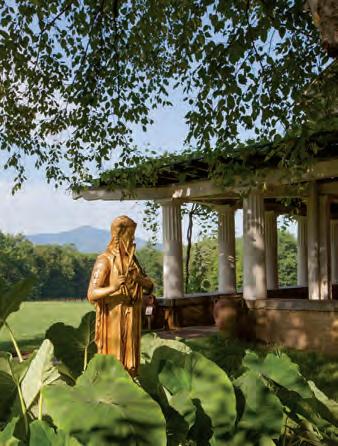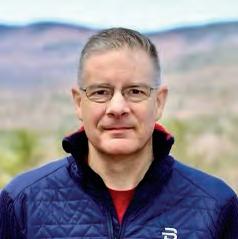
4 minute read
LACONIA: LOCALE HEROES BRYAN & JOHANNA HALPERIN
The performing arts play an important role in bringing people together through imagination and community, and the void of connection felt through empty seats and stages spoke to hearts like Bryan and Johanna Halperin. “People were starving for community connections coming out of the pandemic,” Johanna says. “Theater is great because it is something live and shared in front of you instead of on a screen, which we were all tired of, and brings people together to do something creative and collaborative. People were itching for it, and we were given the opportunity to bridge a gap that we saw in the Laconia community.”
The Halperins — who both have extensive backgrounds in theater — created the Powerhouse Theatre Collaborative in 2020 to continue a program of smaller events at the historic Belknap Mill as the Mill’s creative theater group. The Collaborative strives “to create theatrical opportunities which brighten people’s lives, spark a passion for the performing arts and illuminate aspects of the human condition.” The theater company works with professional directors and designers to provide live theater opportunities for Granite Staters to participate onstage, behind the scenes and in the audience. Named in honor of the Belknap Mill, the group utilizes not only this historic New England building (which turns 200 this year), but also the newly restored Colonial Theatre, located at 609 Main Street. Larger productions take place at the latter, while smaller educational programs are held at the former (and additionally at Rotary Riverside Park, Laconia’s downtown, waterfront public grounds).
“What makes this partnership between the Mill and The Colonial so rewarding is that we are able to bring people together and bring life back into downtown,” Bryan says. “Our shows not only infuse joy back into the community, but into our entire team, too. People come on board from open auditions through the eight-to-10-week length of the production, and they end up leaving at the end with lasting friendships.”
Whether it’s someone’s first or 20th time stepping on stage, the welcoming, supportive environment the Halperins create offers room for both the seasoned veteran and the new kid on the block to find home, together. “We love getting as many people involved as we can and strive to put them in positions to be successful,” Bryan says. “We create a coherent product where everyone brings their own talents to their role and can be a valued member. It is our goal to build ensembles where everyone feels like their time and talents are valued.”
To date, the collaborative has put on over 20 projects of various sizes between the Belknap Mill and Colonial Theatre, and have plenty more to come with the goal of each production to be even more special than the last. Above all else, the Halperins strive to make the Lakes Region a place where art and history intertwine to collaborative, imaginative ends.
— Emily Heidt
BEST PLACE / Reader’s Pick
Thank you so much for the opportunity to share my favorite New Hampshire places. One of them is Saint-Gaudens National Historical Park in Cornish. The spectacular views of Mount Ascutney, the lovely gardens and the amazing sculptures and artwork are good for the soul. It’s my favorite place to recharge and appreciate the beauty of our world. The other is the view from the fire tower atop Mount Prospect in Holderness in the fall. It offers a 360-degree view of the White Mountains and the Connecticut River that, as far as I’m concerned, is one of the best in the state. Many, many more favorite places, but those are my top two. I’ve lived in New Hampshire all of my life (so far) and just turned 70. (How did that happen so fast?)

— Mary Hildreth
Best Place to Immerse Yourself in History
This year’s Portsmouth 400th is an event four centuries in the making. This spring and summer, the Seacoast will be festooned with events and other portals to the past, but the guidebook to the whole shebang is “A History of Portsmouth NH in 101 Objects” (Piscataqua Press). Described as a “crowd-sourced compendium of objects and ideas,” the 224-page book features a curation of 101 colorful images and essays by 80 different authors to illuminate them. The book is available from Portsmouth’s RiverRun Bookstore on Daniel Street (and online at riverrunbookstore.com) and a companion website includes a map leading to locations where the objects can be viewed by the public — 101objectsportsmouthnh.org
BEST PLACES FOR BIGFOOT: Tom Baker’s tips for explorers


New Hampshire’s abundant deep forests and rumpled terrain is apparently the perfect ecosystem for a certain non-human, hairy biped, affectionately known as Bigfoot. Tom Baker is a New Hampshire bigfoot researcher of note who was recently featured on the front page of the Conway Daily Sun. We reached out to ask him for some hot spots and tips for any cryptozoologists (or intrepid bigfoot fans) who might want to know before setting out in search of tracks and scat. Here are a few hot spots he says readers might find helpful. (By the way, Baker notes that “bigfoot” should commonly be written with a lowercase “b” since it’s just another animal name, like “cow.”)
Hemenway State Forest in Tamworth: There have been multiple Class A and Class B sightings in this area, and it’s very near the Ossipee Mountain range which appears to be heating up in terms of encounters.
Nash Stream Forest Area in Coös County: Coös County has, by far, the lowest human population, is largest in size and forested acres, but has the most bigfoot encounters in the state. This is significant because there is an inverse correlation between population and encounters; something not normally seen.
The triangle made between Greenville, Temple and Sharon: Hillsborough County has a higher-than-average sighting count, and the area northwest of Greenville has seen what could be considered relatively increased activity since 2016.
TOM BAKER OFFERS THE FOLLOWING TIPS FOR EXPLORERS:
• Do your research before launching an expedition. Know the area and the ways to get in, but most importantly, the ways to get out.
• Tell someone reliable where you’re going and when you’re expected to return.
• Bring more water than you expect to use. Better too much than too little water. Water filtering systems are a great way to get water out of reliably running streams.
• Leave no trace when hiking and/or camping. Pack out whatever you pack in (including your garbage).
• Be tick aware. Wear long pants pre-coated with Permethrin, and if not allergic, use bug repellants with DEET (yes — I know — awful stuff, but so is Lyme disease).
• Dress for the weather (there is no such thing as bad weather, just unprepared bigfoot researchers). Bring extra batteries for any equipment you may want to bring with you (SLR, FLIR and NVD cameras, parabolic microphones and recorders, etc.).
• Tom Baker says a great website for bigfoot researchers, both aspiring and accomplished, is olympicproject.com.
Bigfoot?










